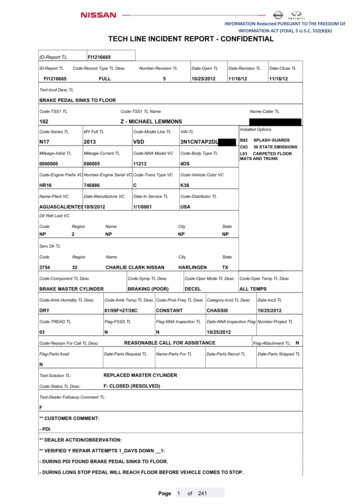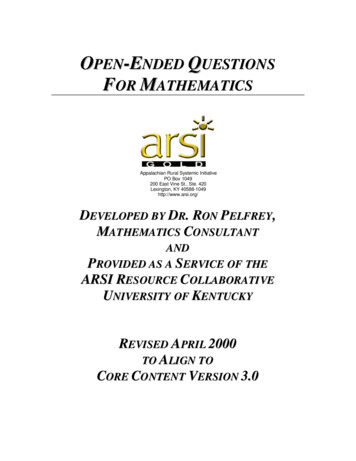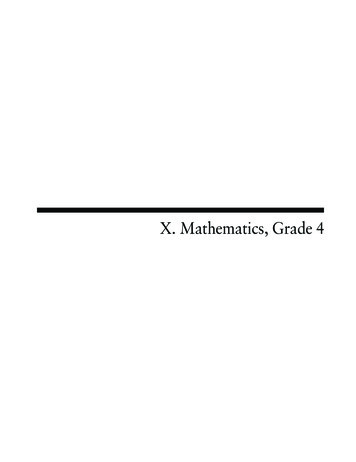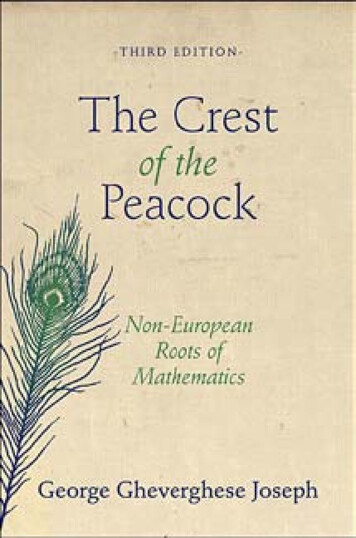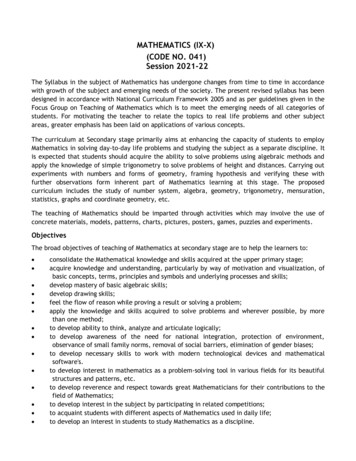
Transcription
MATHEMATICS (IX-X)(CODE NO. 041)Session 2021-22The Syllabus in the subject of Mathematics has undergone changes from time to time in accordancewith growth of the subject and emerging needs of the society. The present revised syllabus has beendesigned in accordance with National Curriculum Framework 2005 and as per guidelines given in theFocus Group on Teaching of Mathematics which is to meet the emerging needs of all categories ofstudents. For motivating the teacher to relate the topics to real life problems and other subjectareas, greater emphasis has been laid on applications of various concepts.The curriculum at Secondary stage primarily aims at enhancing the capacity of students to employMathematics in solving day-to-day life problems and studying the subject as a separate discipline. Itis expected that students should acquire the ability to solve problems using algebraic methods andapply the knowledge of simple trigonometry to solve problems of height and distances. Carrying outexperiments with numbers and forms of geometry, framing hypothesis and verifying these withfurther observations form inherent part of Mathematics learning at this stage. The proposedcurriculum includes the study of number system, algebra, geometry, trigonometry, mensuration,statistics, graphs and coordinate geometry, etc.The teaching of Mathematics should be imparted through activities which may involve the use ofconcrete materials, models, patterns, charts, pictures, posters, games, puzzles and experiments.ObjectivesThe broad objectives of teaching of Mathematics at secondary stage are to help the learners to: consolidate the Mathematical knowledge and skills acquired at the upper primary stage; acquire knowledge and understanding, particularly by way of motivation and visualization, ofbasic concepts, terms, principles and symbols and underlying processes and skills; develop mastery of basic algebraic skills; develop drawing skills; feel the flow of reason while proving a result or solving a problem; apply the knowledge and skills acquired to solve problems and wherever possible, by morethan one method; to develop ability to think, analyze and articulate logically; to develop awareness of the need for national integration, protection of environment,observance of small family norms, removal of social barriers, elimination of gender biases; to develop necessary skills to work with modern technological devices and mathematicalsoftware's. to develop interest in mathematics as a problem-solving tool in various fields for its beautifulstructures and patterns, etc. to develop reverence and respect towards great Mathematicians for their contributions to thefield of Mathematics; to develop interest in the subject by participating in related competitions; to acquaint students with different aspects of Mathematics used in daily life; to develop an interest in students to study Mathematics as a discipline.
COURSE STRUCTURE CLASS –IXUnitsIIIIIIIVVVIUnit NameNUMBER SYSTEMSALGEBRACOORDINATE GEOMETRYGEOMETRYMENSURATIONSTATISTICS & PROBABILITYTotalMarks08170428131080UNIT I: NUMBER SYSTEMS1.REAL NUMBERS(16 Periods)1. Review of representation of natural numbers, integers, and rational numbers on the numberline. Representation of terminating / non-terminating recurring decimals onthe number linethrough successive magnification. Rational numbers as recurring/ terminating decimals.Operations on real numbers.2. Examples of non-recurring/non-terminating decimals. Existence of non-rational numbers(irrational numbers) such as ,and their representation on the number line. Explainingthat every real number is represented by a unique point on the number line and conversely,viz. every point on the number line represents a unique real number.3. Definition of nth root of a real number.4. Rationalization (with precise meaning) of real numbers of the typeand(and their combinations) where x and y are natural number and a and b areintegers.5. Recall of laws of exponents with integral powers. Rational exponents with positive real bases(to be done by particular cases, allowing learner to arrive at the general laws.)UNIT II: ALGEBRA1.POLYNOMIALS(23) PeriodsDefinition of a polynomial in one variable, with examples and counter examples. Coefficientsof a polynomial, terms of a polynomial and zero polynomial. Degree of a polynomial. Constant,linear, quadratic and cubic polynomials. Monomials, binomials, trinomials. Factors andmultiples. Zeros of a polynomial. Motivate and State the Remainder Theorem with examples.Statement and proof of the Factor Theorem. Factorization of ax2 bx c, a 0 where a, b andc are real numbers, and of cubic polynomials using the Factor Theorem.Recall of algebraic expressions and identities. Verification of identities : and their use in factorization of polynomials.
2. LINEAR EQUATIONS IN TWO VARIABLES(14) PeriodsRecall of linear equations in one variable. Introduction to the equation in two variables.Focus on linear equations of the type ax by c 0. Explain that a linear equation in twovariables has infinitely many solutions and justify their being written as ordered pairs of realnumbers, plotting them and showing that they lie on a line. Graph of linear equations in twovariables. Examples, problems from real life, including problems on Ratio and Proportionand with algebraic and graphical solutions being done simultaneously.UNIT III: COORDINATE GEOMETRYCOORDINATE GEOMETRY(6) PeriodsThe Cartesian plane, coordinates of a point, names and terms associated with thecoordinate plane, notations, plotting points in the plane.UNIT IV: GEOMETRY1. INTRODUCTION TO EUCLID'S GEOMETRY (Not for assessment)(6) PeriodsHistory - Geometry in India and Euclid's geometry. Euclid's method of formalizing observedphenomenon into rigorous Mathematics with definitions, common/obvious notions,axioms/postulates and theorems. The five postulates of Euclid. Equivalent versions of the fifthpostulate. Showing the relationship between axiom and theorem, for example:(Axiom) 1. Given two distinct points, there exists one and only one line through them.(Theorem) 2. (Prove) Two distinct lines cannot have more than one point in common.2.LINES AND ANGLES(13) Periods1. (Motivate) If a ray stands on a line, then the sum of the two adjacent angles so formed is 180 Oand the converse.2. (Prove) If two lines intersect, vertically opposite angles are equal.3. (Motivate) Results on corresponding angles, alternate angles, interior angles when atransversal intersects two parallel lines.4. (Motivate) Lines which are parallel to a given line are parallel.5. (Prove) The sum of the angles of a triangle is 180O.6. (Motivate) If a side of a triangle is produced, the exterior angle so formed is equal to the sumof the two interior opposite angles.3.TRIANGLES(20) Periods1. (Motivate) Two triangles are congruent if any two sides and the included angle of one triangleis equal to any two sides and the included angle of the other triangle (SAS Congruence).2. (Prove) Two triangles are congruent if any two angles and the included side of one triangle isequal to any two angles and the included side of the other triangle (ASA Congruence).
3. (Motivate) Two triangles are congruent if the three sides of one triangle are equal to threesides of the other triangle (SSS Congruence).4. (Motivate) Two right triangles are congruent if the hypotenuse and a side of one triangle areequal (respectively) to the hypotenuse and a side of the other triangle. (RHS Congruence)5. (Prove) The angles opposite to equal sides of a triangle are equal.6. (Motivate) The sides opposite to equal angles of a triangle are equal.7. (Motivate) Triangle inequalities and relation between ‘angle and facing side' inequalities intriangles.4.QUADRILATERALS(10) Periods1. (Prove) The diagonal divides a parallelogram into two congruent triangles.2. (Motivate) In a parallelogram opposite sides are equal, and conversely.3. (Motivate) In a parallelogram opposite angles are equal, and conversely.4. (Motivate) A quadrilateral is a parallelogram if a pair of its opposite sides is parallel and equal.5. (Motivate) In a parallelogram, the diagonals bisect each other and conversely.6. (Motivate) In a triangle, the line segment joining the mid points of any two sides is parallel tothe third side and in half of it and (motivate) its converse.5.AREA(7) PeriodsReview concept of area, recall area of a rectangle.1. (Prove) Parallelograms on the same base and between the same parallels have equal area.2. (Motivate) Triangles on the same base (or equal bases) and between the same parallels areequal in area.6.CIRCLES(15) PeriodsThrough examples, arrive at definition of circle and related concepts-radius, circumference,diameter, chord, arc, secant, sector, segment, subtended angle.1. (Prove) Equal chords of a circle subtend equal angles at the center and (motivate) itsconverse.2. (Motivate) The perpendicular from the center of a circle to a chord bisects the chord andconversely, the line drawn through the center of a circle to bisect a chord is perpendicular tothe chord.3. (Motivate) There is one and only one circle passing through three given non-collinear points.4. (Motivate) Equal chords of a circle (or of congruent circles) are equidistant from the center (ortheir respective centers) and conversely.5. (Prove) The angle subtended by an arc at the center is double the angle subtended by it at anypoint on the remaining part of the circle.6. (Motivate) Angles in the same segment of a circle are equal.7. (Motivate) If a line segment joining two points subtends equal angle at two other points lyingon the same side of the line containing the segment, the four points lie on a circle.8. (Motivate) The sum of either of the pair of the opposite angles of a cyclic quadrilateral is 180 and its converse.
7.CONSTRUCTIONS(10) Periods1. Construction of bisectors of line segments and angles of measure 60o, 90o, 45o etc., equilateraltriangles.2. Construction of a triangle given its base, sum/difference of the other two sides and one baseangle.3. Construction of a triangle of given perimeter and base angles.UNIT V: MENSURATION1.AREAS(4) PeriodsArea of a triangle using Heron's formula (without proof) and its application in finding the areaof a quadrilateral.2.SURFACE AREAS AND VOLUMES(12) PeriodsSurface areas and volumes of cubes, cuboids, spheres (including hemispheres) and rightcircular cylinders/cones.UNIT VI: STATISTICS & PROBABILITY1.STATISTICS(13) PeriodsIntroduction to Statistics: Collection of data, presentation of data — tabular form, ungrouped /grouped, bar graphs, histograms (with varying base lengths), frequency polygons. Mean,median and mode of ungrouped data.2.PROBABILITY(9) PeriodsHistory, Repeated experiments and observed frequency approach to probability.Focus is on empirical probability. (A large amount of time to be devoted to groupand toindividual activities to motivate the concept; the experiments to be drawn from real - lifesituations, and from examples used in the chapter on statistics).
MATHEMATICSQUESTION PAPER DESIGNCLASS – IX (2021-22)Time: 3 Hrs.Max. Marks: 80S.Typology of ing: Exhibit memory of previously learned material byrecalling facts, terms, basic concepts, and answers.Understanding: Demonstrate understanding of facts and ideas byorganizing, comparing, translating, interpreting, giving descriptions,and stating main ideas43542Applying: Solve problems to new situations by applying acquiredknowledge, facts, techniques and rules in a different way.1924182280100Analysing :Examine and break information into parts by identifying motives orcauses. Make inferences and find evidence to supportgeneralizations3Evaluating:Present and defend opinions by making judgments aboutinformation, validity of ideas, or quality of work based on a set ofcriteria.Creating:Compile information together in a different way by combiningelements in a new pattern or proposing alternative solutionsTotalINTERNAL ASSESSMENTPen Paper Test and Multiple Assessment (5 5)PortfolioLab Practical (Lab activities to be done from the prescribed books)20 MARKS10 Marks05 Marks05 Marks
COURSE STRUCTURE CLASS –XUnitsIIIIIIIVVVIVIIUnit NameMarks0620061512101180NUMBER SYSTEMSALGEBRACOORDINATE GEOMETRYGEOMETRYTRIGONOMETRYMENSURATIONSTATISTICS & PROBABILTYTotalUNIT I: NUMBER SYSTEMS1. REAL NUMBER(15) PeriodsEuclid’s division lemma, Fundamental Theorem of Arithmetic - statements afterreviewing work done earlier and after illustrating and motivating through examples,Proofs of irrationality ofDecimal representation of rational numbers intermsof terminating/non-terminating recurring decimals.UNIT II: ALGEBRA1.POLYNOMIALS(7) PeriodsZeros of a polynomial. Relationship between zeros and coefficients of quadraticpolynomials. Statement and simple problems on division algorithm for polynomials withreal coefficients.2.PAIR OF LINEAR EQUATIONS IN TWO VARIABLESPair of linear equations in twosolution, consistency/inconsistency.variables(15) Periodsandgraphicalmethodof theirAlgebraic conditions for number of solutions. Solution of a pair of linear equations in twovariables algebraically - by substitution, by elimination and by cross multiplicationmethod. Simple situational problems. Simple problems on equations reducible to linearequations.3.QUADRATIC EQUATIONS(15) PeriodsStandard form of a quadratic equation ax2 bx c 0, (a 0). Solutions of quadraticequations (only real roots) by factorization, and by using quadratic formula. Relationshipbetween discriminant and nature of roots.Situational problems based on quadratic equations related to day to day activities to beincorporated.
4.ARITHMETIC PROGRESSIONS(8) PeriodsMotivation for studying Arithmetic Progression Derivation of the n th term and sum of thefirst n terms of A.P. and their application in solving daily life problems.UNIT III: COORDINATE GEOMETRY1.LINES (In two-dimensions)(14) PeriodsReview: Concepts of coordinate geometry, graphs of linear equations. Distance formula.Section formula (internal division). Area of a triangle.UNIT IV: GEOMETRY1.TRIANGLES(15) PeriodsDefinitions, examples, counter examples of similar triangles.1. (Prove) If a line is drawn parallel to one side of a triangle to intersect the other twosides in distinct points, the other two sides are divided in the same ratio.2. (Motivate) If a line divides two sides of a triangle in the same ratio, the line is parallelto the third side.3. (Motivate) If in two triangles, the corresponding angles are equal, their correspondingsides are proportional and the triangles are similar.4. (Motivate) If the corresponding sides of two triangles are proportional, theircorresponding angles are equal and the two triangles are similar.5. (Motivate) If one angle of a triangle is equal to one angle of another triangle and thesides including these angles are proportional, the two triangles are similar.6. (Motivate) If a perpendicular is drawn from the vertex of the right angle of a righttriangle to the hypotenuse, the triangles on each side of the perpendicular are similar tothe whole triangle and to each other.7. (Prove) The ratio of the areas of two similar triangles is equal to the ratio of the squaresof their corresponding sides.8. (Prove) In a right triangle, the square on the hypotenuse is equal to the sum of thesquares on the other two sides.9. (Prove) In a triangle, if the square on one side is equal to sum of the squares on theother two sides, the angles opposite to the first side is a right angle.2.CIRCLES(8) PeriodsTangent to a circle at, point of contact1. (Prove) The tangent at any point of a circle is perpendicular to the radius through thepoint of contact.2. (Prove) The lengths of tangents drawn from an external point to a circle are equal.3. (Motivate) Alternative Segment theorem: If a chord is drawn through the point ofcontact of a tangent to a circle, then the angles made by the chord with the tangent arerespectively equal to the angles subtended by the chord in the alternate segments.
3.CONSTRUCTIONS(8) Periods1. Division of a line segment in a given ratio (internally).2. Tangents to a circle from a point outside it.3. Construction of a triangle similar to a given triangle.UNIT V: TRIGONOMETRY1.INTRODUCTION TO TRIGONOMETRY(10) PeriodsTrigonometric ratios of an acute angle of a right-angled triangle. Proof of theirexistence (well defined); motivate the ratios whichever are defined at 0 and 90 . Valuesof the trigonometric ratios of 300, 450 and 600. Relationships between the ratios.o2.TRIGONOMETRIC IDENTITIESo(15) PeriodsProof and applications of the identity sin2A cos2A 1. Only simple identities to begiven.Trigonometric ratios of complementary angles.3.HEIGHTS AND DISTANCES: Angle of elevation, Angle of Depression. (8) PeriodsSimple problems on heights and distances. Problems should not involve more than tworight triangles. Angles of elevation / depression should be only 30 , 45 , and 60 .UNIT VI: MENSURATION1.AREAS RELATED TO CIRCLES(12) PeriodsMotivate the area of a circle; area of sectors and segments of a circle. Problems basedon areas and perimeter / circumference of the above said plane figures. (In calculatingarea of segment of a circle, problems should be restricted to central angle of 60 , 90 and 120 only. Plane figures involving triangles, simple quadrilaterals and circle shouldbe taken.)2.SURFACE AREAS AND VOLUMES(12) Periods1. Surface areas and volumes of combinations of any two of the following: cubes, cuboids,spheres, hemispheres and right circular cylinders/cones. Frustum of a cone.2. Problems involving converting one type of metallic solid into another and other mixedproblems. (Problems with combination of not more than two different solids be taken).UNIT VII: STATISTICS AND PROBABILITY1.STATISTICS(18) PeriodsMean, median and mode of grouped data (bimodal situation to be avoided). Cumulativefrequency graph.2.PROBABILITY(10) PeriodsClassical definition of probability. Simple problems on finding the probability of anevent.
MATHEMATICS-StandardQUESTION PAPER DESIGNCLASS – X (2021-22)Time: 3 HoursS.No.Typology of QuestionsMax. Marks: 80TotalMarks%Weightage(approx.)Remembering: Exhibit memory of previously learned material byrecalling facts, terms, basic concepts, and answers.1243541924182280100Understanding: Demonstrate understanding of facts and ideas byorganizing, comparing, translating, interpreting, giving descriptions, andstating main ideasApplying: Solve problems to new situations by applying acquiredknowledge, facts, techniques and rules in a different way.Analysing :Examine and break information into parts by identifying motives orcauses. Make inferences and find evidence to support generalizations3Evaluating:Present and defend opinions by making judgments about information,validity of ideas, or quality of work based on a set of criteria.Creating:Compile information together in a different way by combining elementsin a new pattern or proposing alternative solutionsTotalINTERNAL ASSESSMENT20 MARKSPen Paper Test and Multiple Assessment (5 5)10 MarksPortfolio05 MarksLab Practical (Lab activities to be done from the prescribed books)05 Marks
MATHEMATICS-BasicQUESTION PAPER DESIGNCLASS – X (2021-22)Time: 3 HoursS.No.Max. Marks: 80Typology of QuestionsTotalMarks%Weightage(approx.)Remembering: Exhibit memory of previously learned material byrecalling facts, terms, basic concepts, and answers.16075121581080100Understanding: Demonstrate understanding of facts and ideas byorganizing, comparing, translating, interpreting, giving descriptions, andstating main ideas2Applying: Solve problems to new situations by applying acquiredknowledge, facts, techniques and rules in a different way.Analysing :Examine and break information into parts by identifying motives orcauses. Make inferences and find evidence to support generalizations3Evaluating:Present and defend opinions by making judgments about information,validity of ideas, or quality of work based on a set of criteria.Creating:Compile information together in a different way by combining elementsin a new pattern or proposing alternative solutionsTotalINTERNAL ASSESSMENT20 MARKSPen Paper Test and Multiple Assessment (5 5)10 MarksPortfolio05 MarksLab Practical (Lab activities to be done from the prescribed books)05 MarksPRESCRIBED BOOKS:1.Mathematics - Textbook for class IX - NCERT Publication2.Mathematics - Textbook for class X - NCERT Publication3.Guidelines for Mathematics Laboratory in Schools, class IX - CBSE Publication4.Guidelines for Mathematics Laboratory in Schools, class X - CBSE Publication5.Laboratory Manual - Mathematics, secondary stage - NCERT Publication6.Mathematics exemplar problems for class IX, NCERT publication.7.Mathematics exemplar problems for class X, NCERT publication.
6. (Motivate) If a side of a triangle is produced, the exterior angle so formed is equal to the sum of the two interior opposite angles. 3. TRIANGLES (20) Periods 1. (Motivate) Two triangles are congruent if any two sides and the included angle of one triangle is equal to any two si






